77 Facts about Spain (Travelers and Expats) Food, Culture, Visas, Politics, Photos…
Thinking about a move to Spain? I can’t say that I haven’t thought about it a few times. In this guide, you’ll learn 77 facts about Spain, including food, expat, politics, travel, national symbols, and more. Plus a ton of photos and videos.
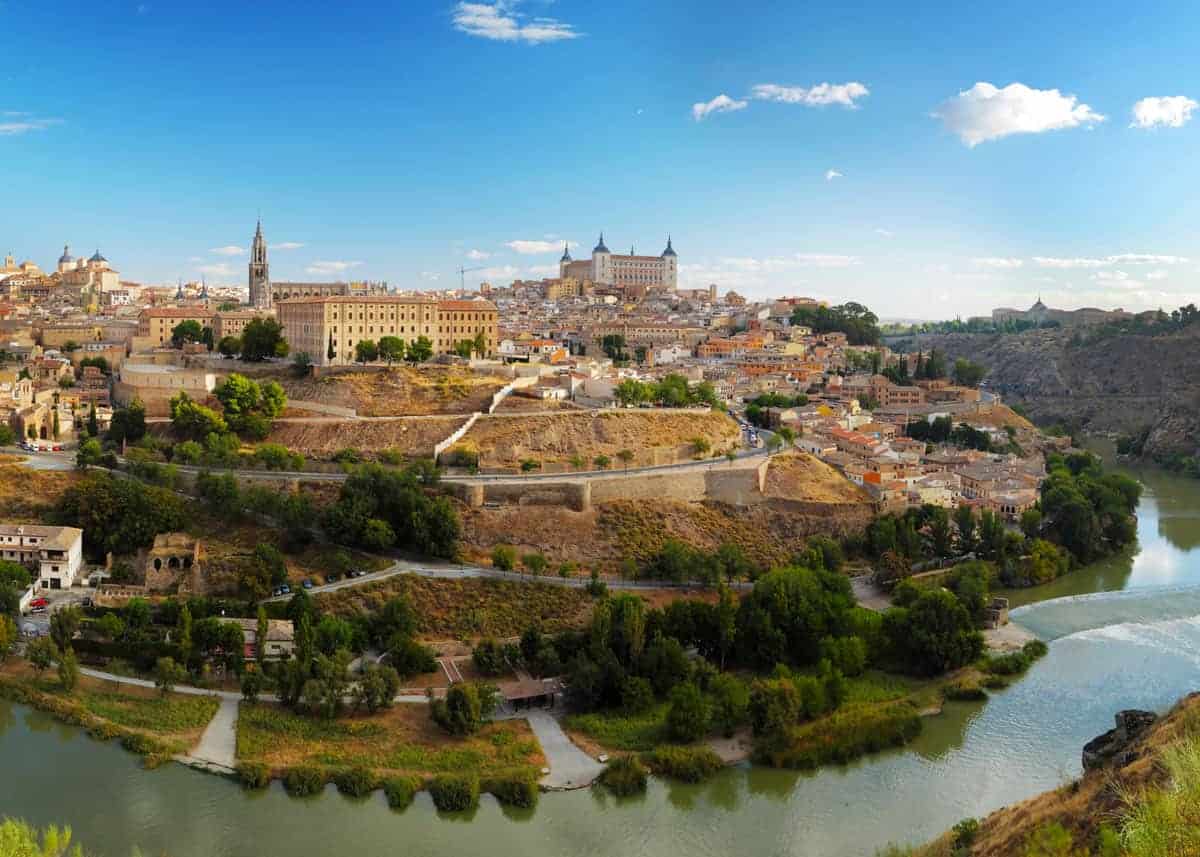
77 Facts about Spain
Those who speak Spanish fluently and feel confident in their skills will have no problem moving to Spain or visiting there for several months or more.
Before you apply for a visa or look at immigration policies, you may want to learn more about the nation through the 80 facts about Spain that I found.
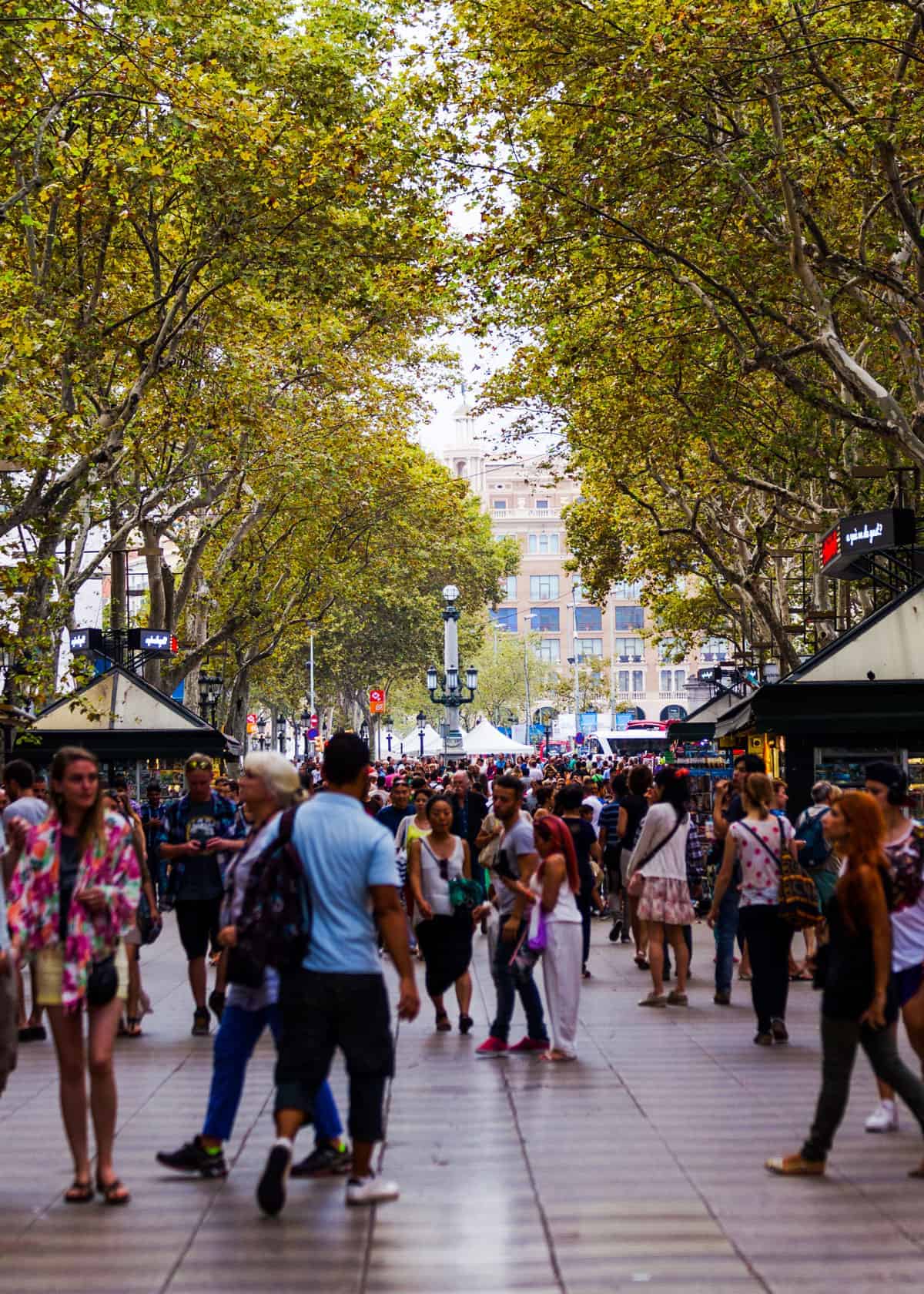
Basic Facts About Spain
1. What is Spain’s official name?
Though you can call the country Spain, its official name is the Kingdom of Spain.
The official name of the country in Spanish is Reino de España. Four other languages have official names for the nation too, including Catalan and Basque.
2. What is Spain’s population?
The population of Spain changes as more people move to and away from the country. An official estimate of the population in 2018 was 46,733,038 people.
This means that each square mile in the country is home to roughly 238 people. The population density is lower in the rural parts of Spain.
The number of people living in the country increased each year over the last few decades. Spain is now the 30th most populous country in the entire world.
3. Where is Spain located?
Spain is a country located in the southwestern region of Europe.
It ranks as one of the four largest countries in Europe. Morocco, France, and Portugal share borders with Spain, but it also shares a border with Gibraltar, a territory owned by the United Kingdom.
Another portion of the country borders North Africa.
Map of Spain
4. What time is it in Spain?
During most of the year, Spain is in the Central European timezone (GMT+1). It follows the UTC +2 timezone in the summer.
The Canary Islands are part of the Western European Standard Time time zone (GMT).
This time zone converter lets you convert the current time in Spain from anywhere in the world.
5. When does the sun set in Spain?
The sun usually sets in Spain around 7 pm, though it may set later in the day during both the spring and summer.
It can set closer to 6 pm during the winter. As the country has long days, you can enjoy more time outside in the sun and warm air.
6. What are citizens of Spain known as?
Though you might use the term Spanish to describe someone from Spain, this term can also refer to any items or products from the country.
Most residents prefer the term Spaniard.
Some of the regional groups that live in Spain include the Basque, Leonese, and Catalan. You should only use those terms if you know for sure that someone belongs to that group.
7. What is the capital of Spain?
Madrid is the Capital of Spain. This city is in the central portion of the country. It ranks as both the largest city in Spain in terms of overall size as well as the largest in terms of residents.
Street View in Madrid Spain
8. What is the life expectancy in Spain?
People in Spain live to an average of 82.83 years old, which is slightly higher than the life expectancy in Italy and other nearby countries.
One survey found that Spaniards now have a longer life expectancy than the Japanese. The first time Spain beat Japan on this list was in the 21st century.
9. What religions are in Spain?
Approximately 67% of people living in Spain identify as Roman Catholic. During the Renaissance period, this number was even higher.
More than 27% of residents say that they do not follow any set religion or that they do not believe in religion. Around 3% of Spaniards follow other religions. You can check out some of the most beautiful churches in Spain, including historic sites and those that still offer services each week.
10. Common misspellings of Spain
As the word Spain has just five letters, you shouldn’t make any mistakes when spelling it. This is probably the most common misspelling: Spein.
Some of the ways you can misspell the name of the country include switching some of the words when you write too fast or using Spainard instead of Spaniard.
Facts about Spain Travel
11. How’s the weather in Spain?
Spain is a large country that is home to three different and distinct regions.
The peninsula areas are part of the Mediterranean climate. Those areas are both warm and dry. Regions in the south and east are semi-arid and can include some deserts. Much of the nation experiences an oceanic climate, which includes regular rainfall and both warm and cool temperatures.
Spain is part of the Iberian Peninsula – one of the largest peninsulas in the world.
12. What is the best time to visit Spain?
The best time to visit Spain can include the late spring or the early fall.
Summer can bring temperatures well above 90 or even 100 degrees Fahrenheit and droughts.
Experts often recommend visiting Spain in September or October when the weather is cooler.
13. What is Spain’s currency?
All countries in the European Union use the euro (€), including Spain.
You can have your cash converted before or after you arrive. Euros come in coins that correspond to one or two euros and smaller denominations as well as bills in sizes up to 500 euros.
14. Do I need a power adapter when I visit Spain?
You will need a power adapter when visiting Spain, but you may also need a voltage adapter. An adapter like this will step down 220v to 110v.
Wall current in Spain (and the rest of Europe) provide a device frying 220v – if you have devices from Canada or the US. The United States also uses 60 Hz, but Spain uses 50 Hz.
Depending on where you live or visit and the electronics you have, you’ll find that you have access to either Type C or Type F plugs. It’s often helpful to get a look at Spanish plugs before your trip.
15. What plugs are used in Spain?
The Type C plug used in Spain is similar to the standard plugs used in America. They have two prongs that are slightly rounded and fit into the holes in the outlet.
A Type F plug will have two rounded prongs that are larger in size and a case that will only fit into the outlet in one way. Something like this adapter will do the trick.
16. What are Spain’s international airports?
There are nearly 40 airports in the Spanish mainland and several others on the islands off the coast.
Approximately 36 of the airports in Spain handle international flights. Those airports include Ibiza Airport, Almería International Airport, and La Palma Airport.
The busiest aiports in Spain include Madrid, Barcelona, Palma de Mallorca, Malaga, Alicante, and Gran Canaria.
17. What languages are spoken in Spain?
The most commonly spoken language in Spain is Spanish or Castilian. Approximately 99% of people born in Spain speak this language.
Regional and official languages in Spain include Basque, Galician, Valencian, and Aranese. Some people also speak a second language such as Italian or English. Deaf people use Spanish Sign Language (SSL) to communicate.
Learn more about the other Spanish-speaking countries.
18. How many tourists visit Spain every year?
Spain is a popular tourist spot and sees the number of tourists visiting increase almost every year. More than 82 million people visit Spain on an annual basis.
Many of those tourists come from European countries, including Italy, France, and Portugal. American tourists also visit Spain in large numbers.
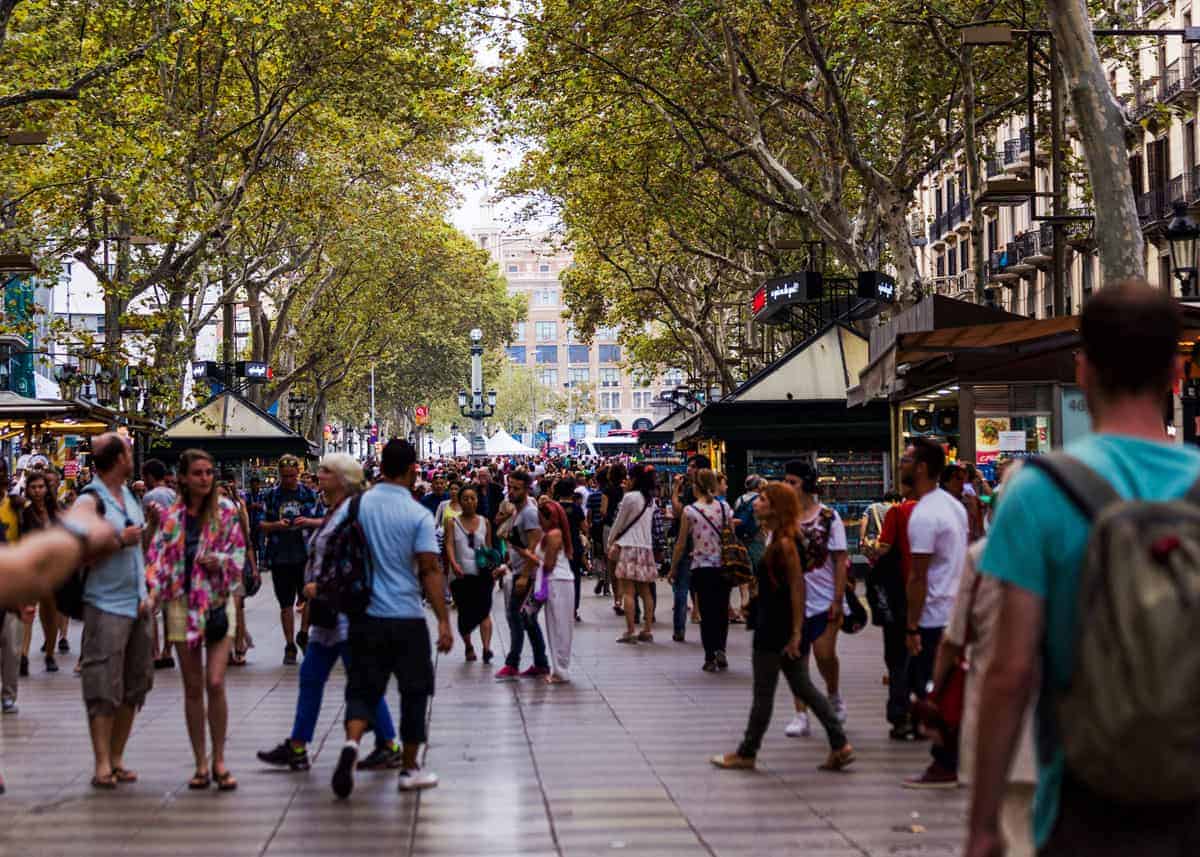
19. What are Spain’s most popular landmarks?
Some of the popular landmarks you can see while in Spain include major and historic churches such as La Sagrada Familia.
- Alhambra and Generalife Gardens, Granada
- Plaza Mayor, Madrid
- La Rambla, Barcelona
- Toledo’s Old City
- The White Towns of Andalucía (Los Pueblos Blancos)
- Costa del Sol Beaches
- Palacio Real, Madrid
- Seville Cathedral and Alcazar
- Santiago de Compostela Cathedral
- Sagrada Familia and Gaudi Sites, Barcelona
- El Teide, Tenerife (Canary Islands)
- The Prado and Paseo del Artes, Madrid
- Ciudad de las Artes y las Ciencias, Valencia
- The Great Mosque of Cordoba
- Guggenheim Museum, Bilbao
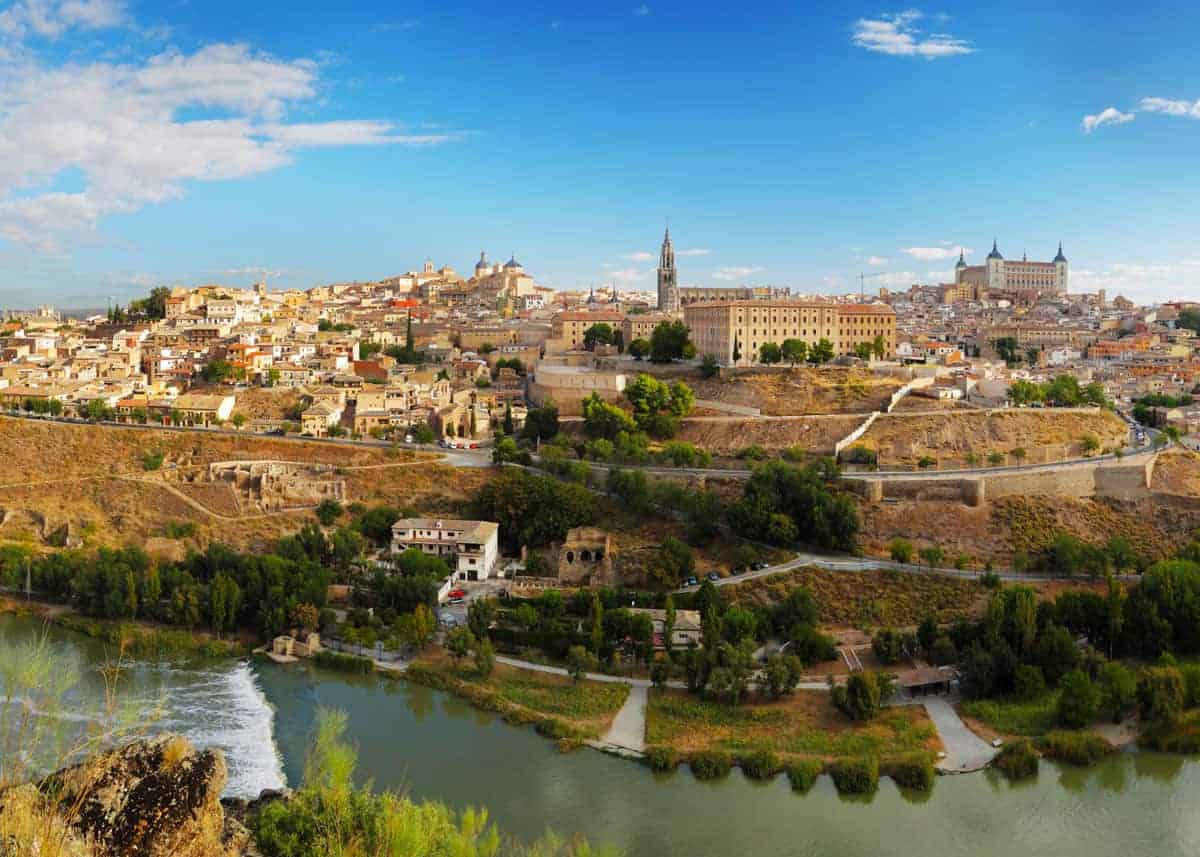
Fans of Gaudi and the artwork he created will want to visit Casa Mila. Park Guell is also home to some of his sculptures.
You can look at some of the top Spanish landmarks as you plan your trip.
20. Is Spain a safe place to visit?
The crime levels in Spain are generally higher in large cities, including Barcelona and Madrid.
With a murder rate of less than one for every 100,000 people, it’s one of the safest countries in Europe. Spain does see some high levels of drug-related crimes though because it serves as a major port for drugs entering the EU.
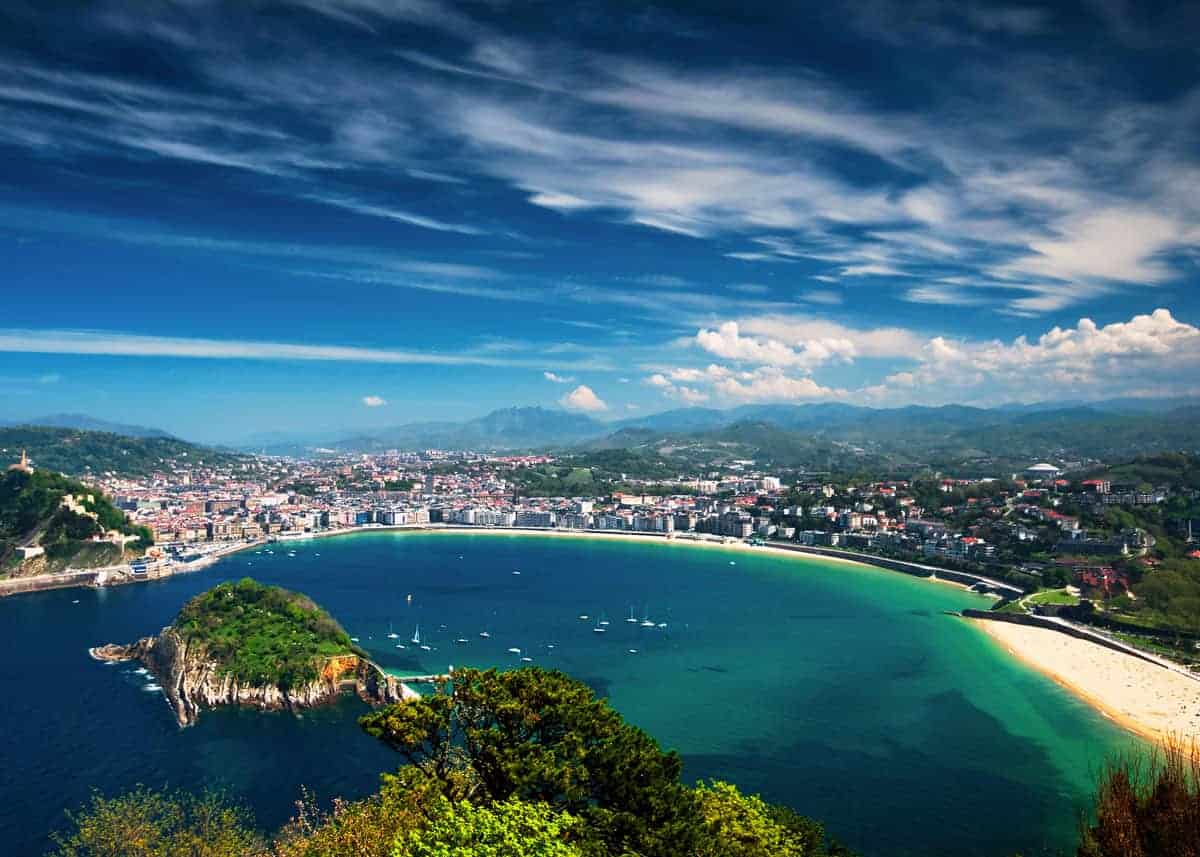
21. What are Spain’s 10 best beaches?
Whether you want to dive into the water, spend some time on a boat or try some adventure sports, you need to find the best beaches in Spain.
Those beaches include San Sebastian, Ibiza, Benidorm and Mallorca.
- Maspalomas, Gran Canaria
- Corralejo, Fuerteventura (Canary Islands)
- Cofete, Fuerteventura (Canary Islands)
- Isuntza Beach, Lekeitio
- Playa de Bolonia, Tarifa
- La Concha Bay, San Sebastian
- Tossa De Mar, Catalonia
- Praia da Rodas, Galicia
- Cala D’en Serra, Ibiza
- Burriana Beach, Nerja
- Es Calo des Moro Beach, Southern Mallorca
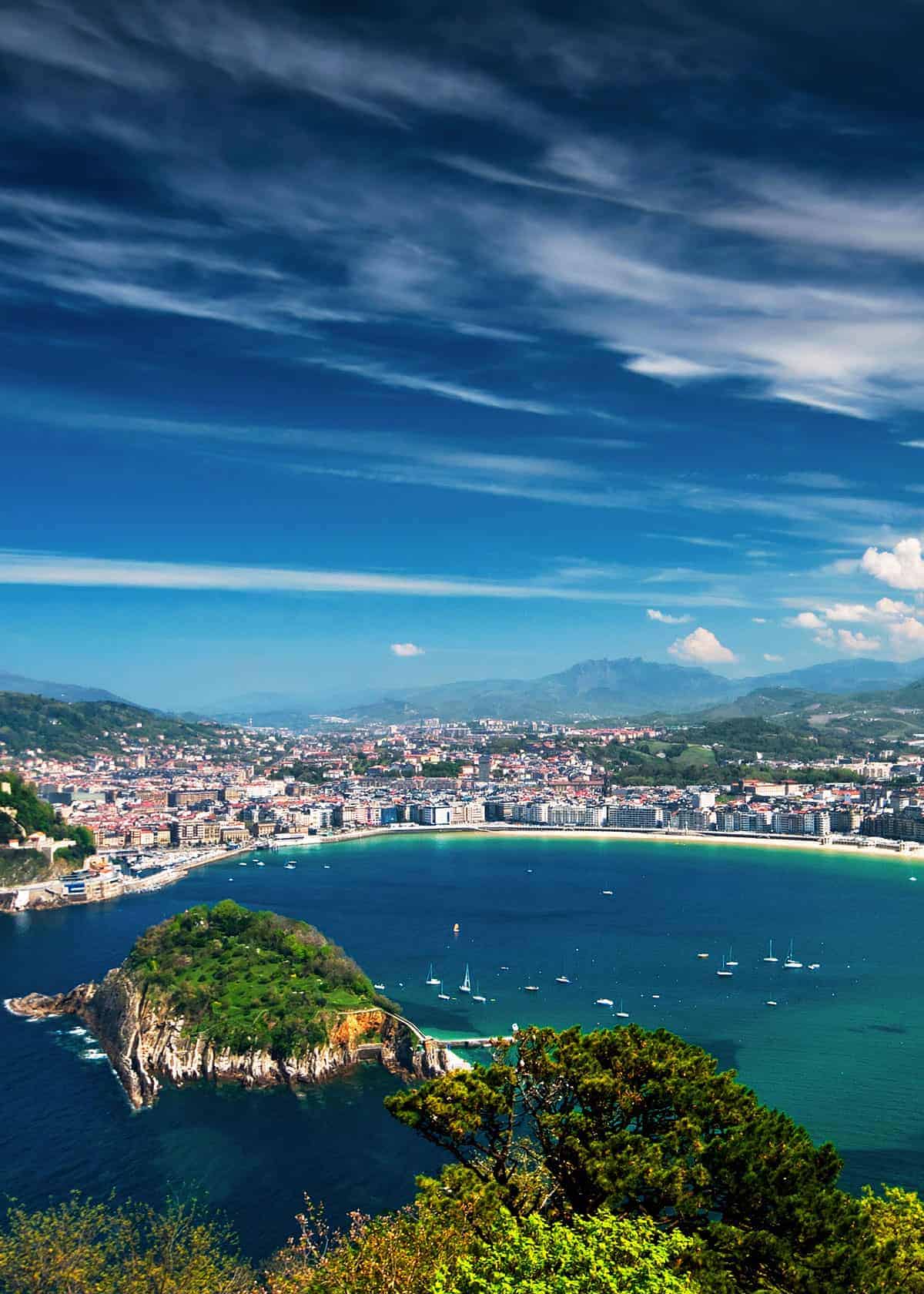
You won’t want to miss the Canary Islands either, which are just off the coast. Other popular beaches include La Concha, Playa de Aiguablava, Rodas, Cala Mondragó and Galicia.
22. What are the most famous events in Spain?
If you know where you want to live or visit, you can look at special events that take place in that city. No matter where you live though, you’ll want to make time for events such as Holy Week in Spain and the Saffron Rose Festival.
Thousands of people head to the Seville Fair each year too.
Some of the more unique events in the country include La Vijanera, which is a major carnival and the Festival of Santa Marta de Ribarteme that honors people who nearly died in major disasters and other events.
Geography in Spain
23. How Large is Spain?
Spain is approximately 195,360 square miles in size, which is 505,990 square kilometers.
Just over 1% of the nation is water, which includes the small lakes on the mainland and the waters that surround some of its islands.
24. What World Heritage Sites are in Spain?
World Heritage Sites include buildings and structures that are historically important to the world at large.
There are 47 World Heritage Sites in Spain and 28 tentative sites on that list.
Those sites include the Historic City of Toledo, Tower of Hercules, Old City of Salamanca and Old Town. UNESCO has a list of all Spanish World Heritage Sites.
25. What is Spain’s largest city?
With a population of more than 5.2 million people, Madrid is the largest city in Spain.
With the urban areas added into this figure, Madrid has a total population of more than 5.8 million residents.
Barcelona is the nation’s second-largest city and has a population of more than 4.2 million people.
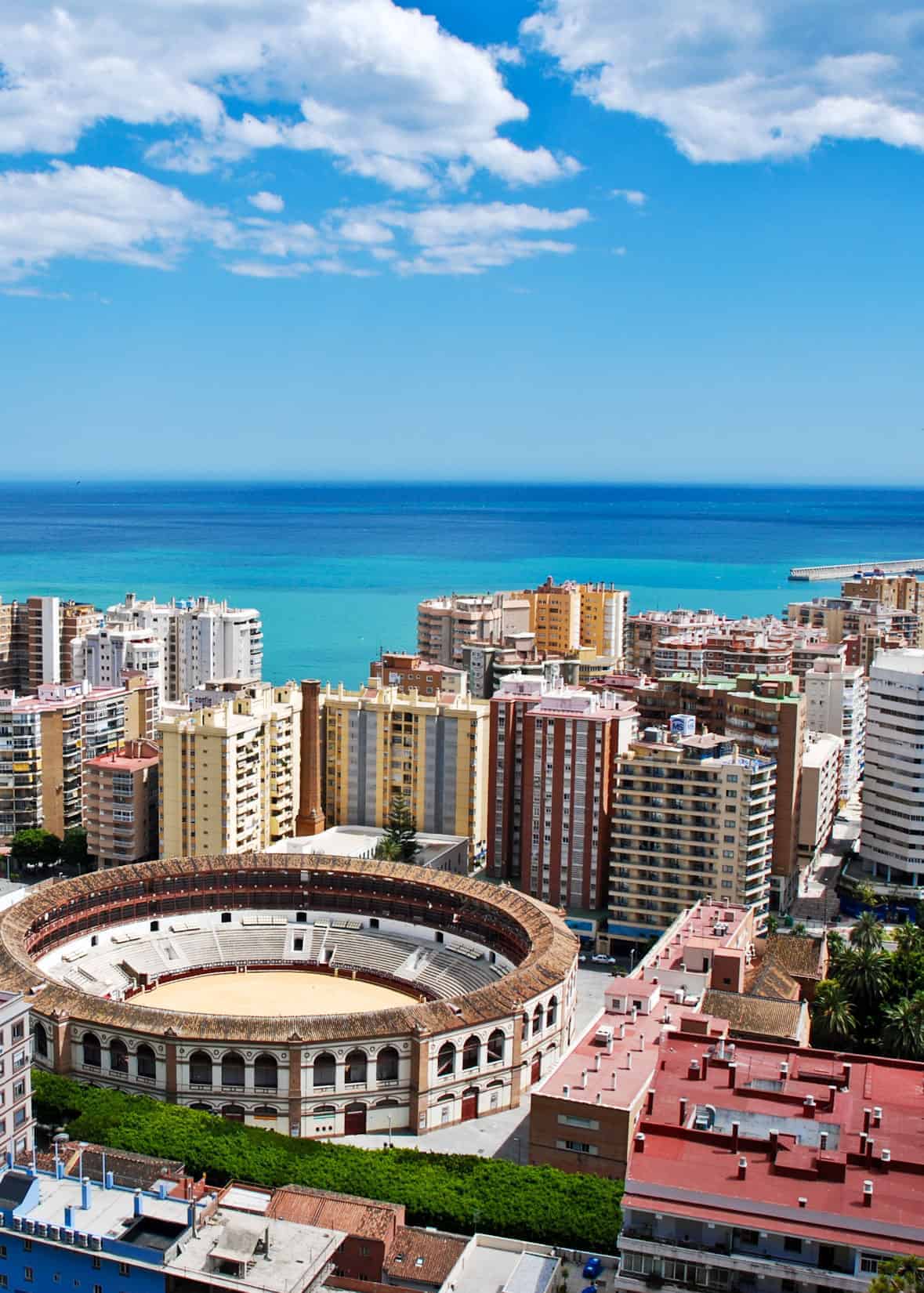
In the past, Spain was known for using donkeys to haul carts. Learn more about them and their miniature friends.
26. What are Spain’s major cities?
The most populous cities in Spain after Madrid and Barcelona are Valencia, Seville, and Bilbao.
- Madrid 5,263,000
- Barcelona 4,251,000
- Valencia 1,499,000
- Seville 1,262,000
- Bilbao 947,000
- Málaga 844,000
- Oviedo–Gijón–Avilés 844,000
- Alicante–Elche 793,000
- Las Palmas 640,000
- Zaragoza 639,000
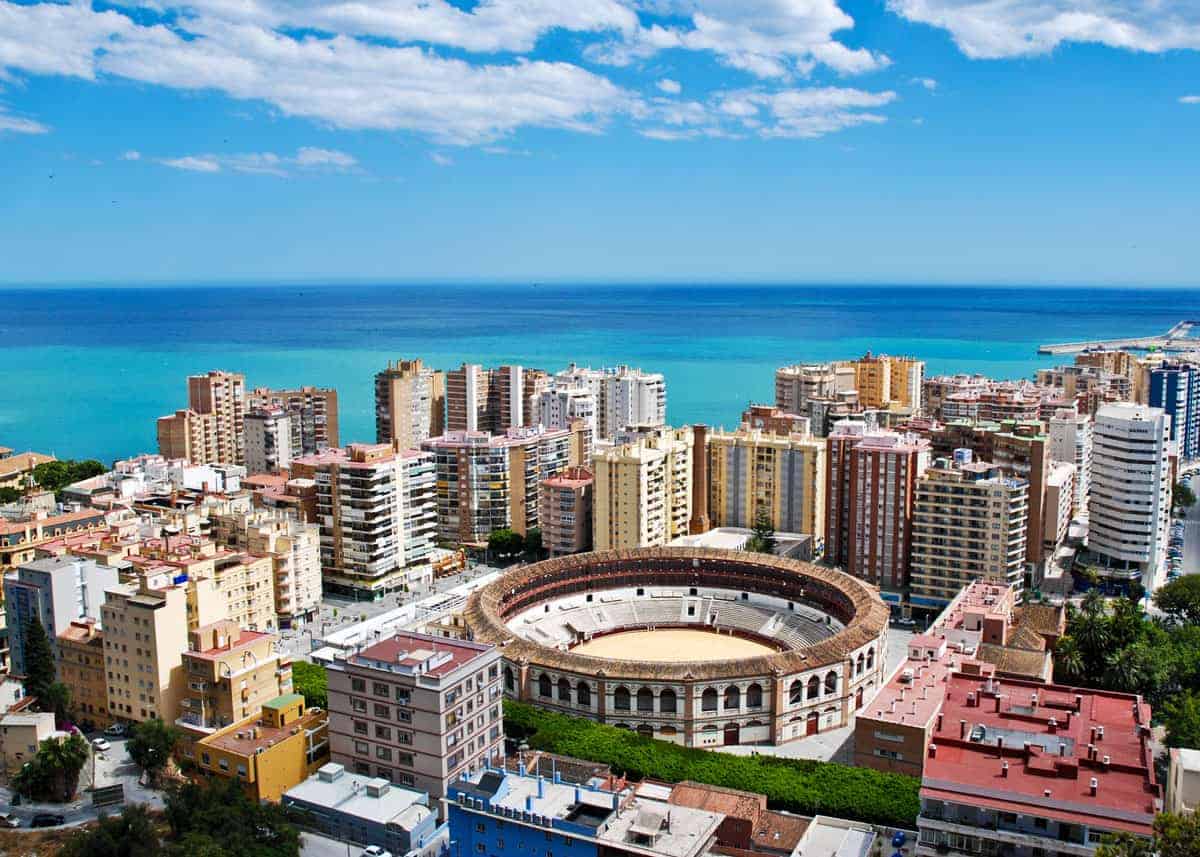
Though Bilbao only has a population of around 940,000, the other two cities are home to more than one million residents each.
27. How many provinces in Spain?
Spain developed a province system in 1833 and officially recognized that system in 1978.
A Royal Decree established 50 provinces in the country and gave each province the authority to design and hang its own flag. Those provinces include regions on the mainland and on the Spanish islands.
Most of the provinces are named after their main town or city.
Spain is furthers organized by 17 autonomous communities and 2 autonomous cities (Ceuta and Melilla).
28. What is the highest elevation in Spain?
Mount Teide is the highest mountain in Spain and the nation’s highest elevation.
It stands approximately 12,195 feet tall. Mount Teide is located on Tenerife Island, Canary Islands.
The second tallest elevation in Spain is Mulhacen, which is 11,411 feet tall.
29. Does Spain have a lot of mountains?
Spain is a relatively mountainous country with more than 100 individual mountains.
The Balearic Islands are home to several mountains with elevations of above 1,000 feet. Those mountains offer activities such as hiking and rock climbing. You can view a list of mountains in Spain to decide which ones to add to your list.
30. How many islands are in Spain?
Ibiza is one of the most popular islands in Spain. It has a reputation as a party destination because of its many nightclubs and bars.
Though there are more than 100 islands in Spain, most have individual names and belong to specific regions.
The most famous islands in Spain include:
- Balearic Islands: Consist of 12 individual islands, including Isla del Aire and Cabrera. This archipelago is located in the western Mediterranean Sea.
- Canary Islands: An 16 island archipelago (8 are inhabited) located off the west coast of Africa.

31. What are the top 10 famous places in Spain?
When tourists pick their favorite destinations and places in Spain, they often name major cities and attractions, including:
- Seville
- Barcelona
- Madrid
- Palacio Real
- La Concha
- Aqueduct of Segovia
- Alhambra and Generalife Gardens
- Sagrada Familia
- Golden Triangle (home to many art museums and galleries)
- Pamplona, especially during the Running of the Bulls
32. How many national parks in Spain?
National parks offer fun activities such as hiking and animal watching. Spain is home to 15 national parks.
There are five parks between the Canary Islands and the Balearic Islands and 10 on the mainland.
Some of those parks include:
- Timanfaya National Park
- Aigüestortes i Estany of Saint Maurici National Park
- Teide National Park
- Ordesa y Monte Perdido National Park
Politics of Spain
33. What type of government does Spain have?
Spain has a constitutional monarchy government, which includes royals who rule along with appointed officials.
King Felipe VI took the throne on June 19, 2014 and now assists both the Prime Minister and the Deputy Prime Minister.
Spain also has a Council of Ministries. It holds general elections and specialty elections to appoint politicians to the European Cabinet. Autonomous regions and communities with Spain have their own elected and appointed officials.
34. How stable is the current government?
Though you might worry about the political climate when you move to some countries, you shouldn’t worry about those issues when moving to Spain. Spain has a stable government that works together to assist residents and tourists visiting the country.
35. How many national political parties are in Spain?
There are seven political parties called the national parties of Spain, including the People’s Party, Spanish Socialist Party, United We Can and Citizens.
Some of the more modern political parties found in Spain are Vox, Animalist Party Against Mistreatment of Animals and Union, Progress and Democracy.
Business in Spain
36. What is Spain’s largest export?
The main and largest export of Spain is refined petroleum. Spain exports refined petroleum with an estimated market value of more than $400 billion. It produces and exports nearly 2% of the total amount of refined petroleum in the world today.
37. What are Spain’s major exports?
Some of the other commodities exported by Spain include citrus fruits, gold, olive oil, and tomatoes.
Cars and other types of vehicles have a total value of more than $30 billion and come from different companies that operate in the nation.
38. What is the minimum wage in Spain?
Spain has a national minimum wage of €1,050 per month. There are plans to increase this amount to €1,202 per month in 2019. Workers who make minimum wage earn €12,600 each year, but many skilled jobs in Spain pay more.
39. Who are Spain’s major trading partners?
As the nation imports more than $43 billion in German goods and products, Germany ranks as one of the top trading partners with Spain. Other trading partners include France, Italy, United States, and China.
Some regions and countries on the Spanish border also trade, including Morocco and Algeria.
Food in Spain
40. What food is most popular in Spain?
The most popular food in Spain is also the national dish, which is paella.
Specifically Paella Valenciana. Because paella originates from Valencia, it is actually a regional dish – it isn’t easy to get good paella everywhere in the country.

Originally made from vegetables mixed with snails and rabbit, it can include any type of meat today. Depending on where you stay, you might find seafood paella or a similar dish that includes seafood.
Paella uses Spanish saffron and is cooked in a pan that produces a crunchy texture on the bottom of the dish.
41. What kind of food is traditional in Spain?
Though paella is very popular, you’ll also find gazpacho served in local restaurants. It includes fresh vegetables and thick tomatoes. The dish is a soup that you eat cold.
Chorizo is a traditional ingredient used in Spanish cooking. It’s a type of cured sausage that is quite spicy.
Spanish omelets and sangria are other traditional Spanish dishes.
42. What can you eat and drink in Spain?
If you want to eat like a Spaniard, consider stopping by a fast food restaurant such as Maoz or Munchies, Hot Dogs, and More. You can grab hot dogs, burgers, and other dishes that remind you of home as well as some authentic Spanish snacks.
Some of the other foods you should try in Spain include gambas al ajillo, pisto and pollo al ajillo.
43. What is Spain’s national dish?
Paella is the official dish in Spain, though you’ll find many different versions served in different regions.
To qualify as paella, it must include rice with a crunchy bottom and saffron, which gives the rice its classic yellow look. Paella can incorporate any type of meat, including prawns, sausage and chicken.
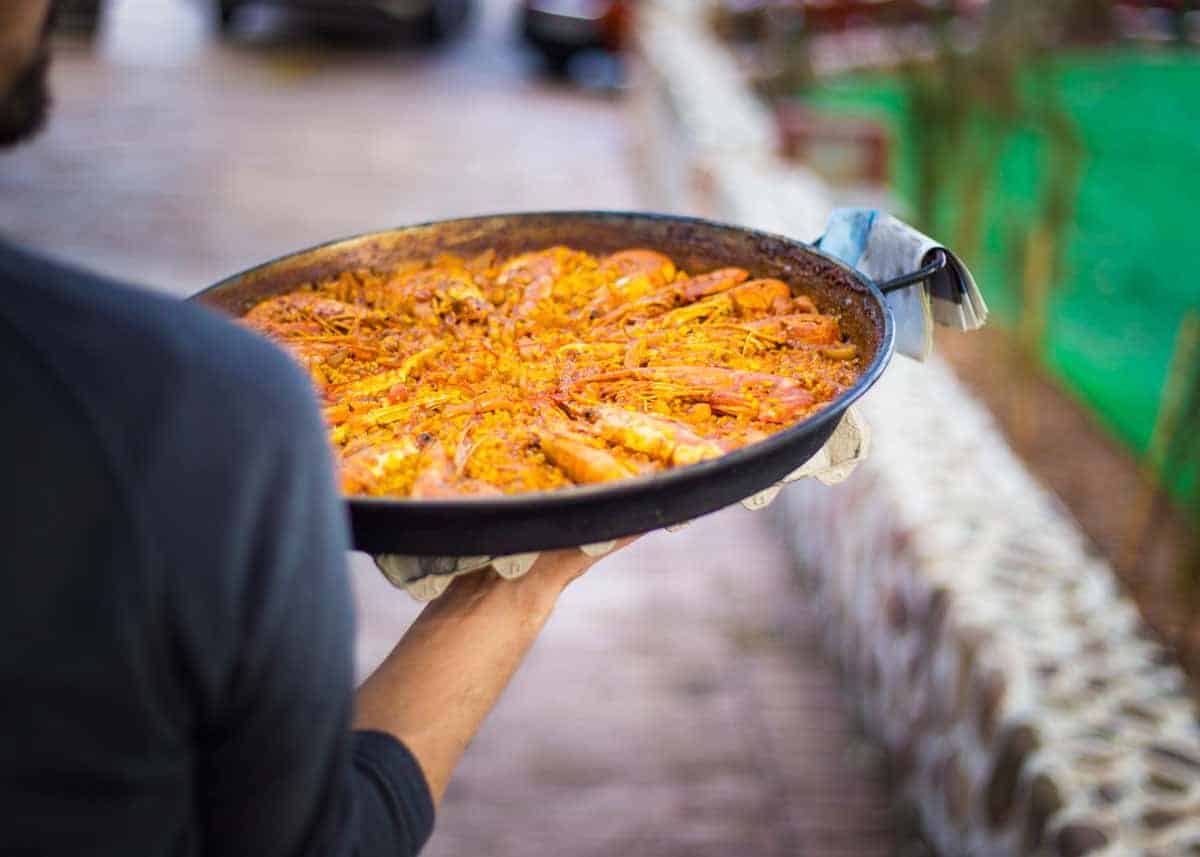
44. What is a typical dinner in Spain?
Spaniards typically eat a smaller dinner because they have a large meal in the middle of the day. They work from 9 am to 2 pm or later, take a two-hour lunch and then work until 8 or 9 pm.
Dinner usually includes light fare such as fresh seafood steamed with lemon and olive oil or a salad dressed in olive oil and lemon.
45. What is the most popular drink in Spain?
If Spain had a national drink, it would be sangria. This alcohol drink mixes wine with thin slices of fresh fruits. You can have a glass with lunch or dinner. Locals also like the soft drinks made in Spain, including Kas, Clipper, and Miranda.
The energy drink Missile is also popular.
46. What do the locals eat for breakfast?
Tostada con tomate is a popular breakfast food in France. This is a light tomato dish mixed with fresh herbs served on top of crunchy bread.
Churros are a popular alternative. When you eat this freshly cooked doughnuts, you can dip them into coffee or hot chocolate. Churros usually have a sprinkle of sugar on top.
Here’s how to order (and eat) churros in Spain.
47. What food and drink is Spain famous for?
Most of the dishes that are famous in Spain include those mentioned above.
If Spanish food had to be summed up in one word, it would probably be tapas.
Locals also love Spanish omelets, which mixes eggs and fresh herbs with potatoes. Some recipes include other fresh vegetables. You can eat the omelets hot or cold with a glass of sparkling water, sangria or soda.
The Spanish heavily influenced Filipino food.
48. What fruit is Spain famous for?
As citrus fruits are among its largest exports, it’s not surprising that many know Spain for these fruits. Though lemons and limes are popular, most know Spain for its oranges, which are bright in color and juicy on the inside.
Some of the fruits native to Spain include apples, figs, cherries, bananas, and peaches.
49. Can I drink the water in Spain?
Yes. You absolutely can drink the water in Spain because more than 99% of the water that comes from the tap is safe. It’s important that you use your best judgment though. If the water appears cloudy or has an unusual taste, you should avoid it.
Language in Spain
50. What are the official languages in Spain?
Spain has five national languages, including one main language and those spoken in select regions.
Castilian is the main national language and what people in other countries refer to as Spanish. Catalan, Aranès, Basque, and Galician are the four regional languages spoken in Spain.
While traveling in Spain, a basic phrasebook is invaluable. Just open and read the phonetic phrases. Or show it to the person you’re trying to communicate with. If you want to go a little deeper in the language, you should consider Madrigals Magic Key to Spanish. It breaks the language down into easy to understand components. A must for anyone moving to Spain.
Want to really learn the language? Check out this guide about the best way to learn Spanish. It covers the 3 primary ways, with specific suggestions and personal experiences.
51. What language are road signs in Spain?
All the road signs posted on the streets in Spain use Spanish/Castilian.
As you venture into certain regions, you may find that those signs use both Spanish and a regional language. Spain has some unique road signs that warn you of wild animals, including jellyfish and giraffes.
Wildlife in Spain
52. What animals live in Spain?
The Iberian pig is just one of the animals native to Spain. This is the same type of pig used to make the ham known around the world.
The Golden Eagle and Iberian Lynx are both natives also. Some of the other animals you may come across while in Spain include genets, vultures, beavers and bears.
You can also find the tiny Etruscan shrew in Spain.
53. What is Spain’s national animal?
As the Running of the Bulls takes place in Pamplona every year, it’s not surprising that the national animal of Spain is the bull.
The bull appears on the country’s flags and government documents. You can watch bullfights in different Spanish cities too.
54. What dangerous animals are in Spain?
One of the more dangerous animals found in Spain is the black bear. As long as you leave the bears alone though, they shouldn’t bother you.
Wild pigs, lynx cats and ibexes can attack when provoked. You should avoid any area off the beaten path unless you have the proper safety gear and an understanding of the wildlife of that area.
55. Are there any deadly spiders in Spain?
No matter where you stay in Spain, you may run across a deadly spider or two.
Spain is home to both the Black Widow and the Brown Recluse. A bite from either one can send you into shock and possibly lead to death. Other dangerous spiders found in Spain include the Mediterranean Tarantula and the Mediterranean Funnel Web Spider.
Plant life in Spain
56. What is Spain national flower?
The national flower of Spain is the red carnation. It has the scientific name Dianthus caryophyllus, but locals use the word clavel to describe it.
57. What types of vegetation are common in Spain?
Only a small portion of the country is covered in dense woodland. And this is primarily found in the mountains.
In northern Spain, you’ll find oak, beech, and heath. You will also find Portuguese oak and a variety of pine. You’ll find evergreen oak and small shrubs in southern Spain.
Carnations and other types of flowers grow wild across Spain. Some of the other types of vegetation you might see include forests filled with oak trees and both lime and chestnut trees.
58. What crops are grown in Spain?
Most of the crops grown in Spain include the fruits and vegetables that local farmers send to stores across the country and those they export to other nations. Those crops include olives, lemons, limes, oranges, apples, and saffron.
National Symbols of Spain
59. What is the symbol of Spain?
Spain uses its official flag as its national symbol. This flag includes an image of a red carnation and a bull. You’ll see those images as part of the coat of arms of the Royal Family on the flag.
60. What is the national tree of Spain?
Spain picked the Quercus Ilex as its national tree. Better known as the evergreen oak, it also grows in parts of the United States, usually around the south.
61. What is Spain’s national bird?
The Spanish imperial eagle serves as the national bird of Spain. This eagle is on the threatened list because its numbers dropped over the last few decades.
62. What is Spain’s national animal?
Spain’s national animal is the bull. The bull has a major role in the design of the country’s flag.
63. What is Spain’s national sport?
Football is the national sport and game of Spain. Though Europe calls the game football, Americans call it soccer.
Formula 1, gymnastics, bullfighting and basketball are other popular sports in Spain.
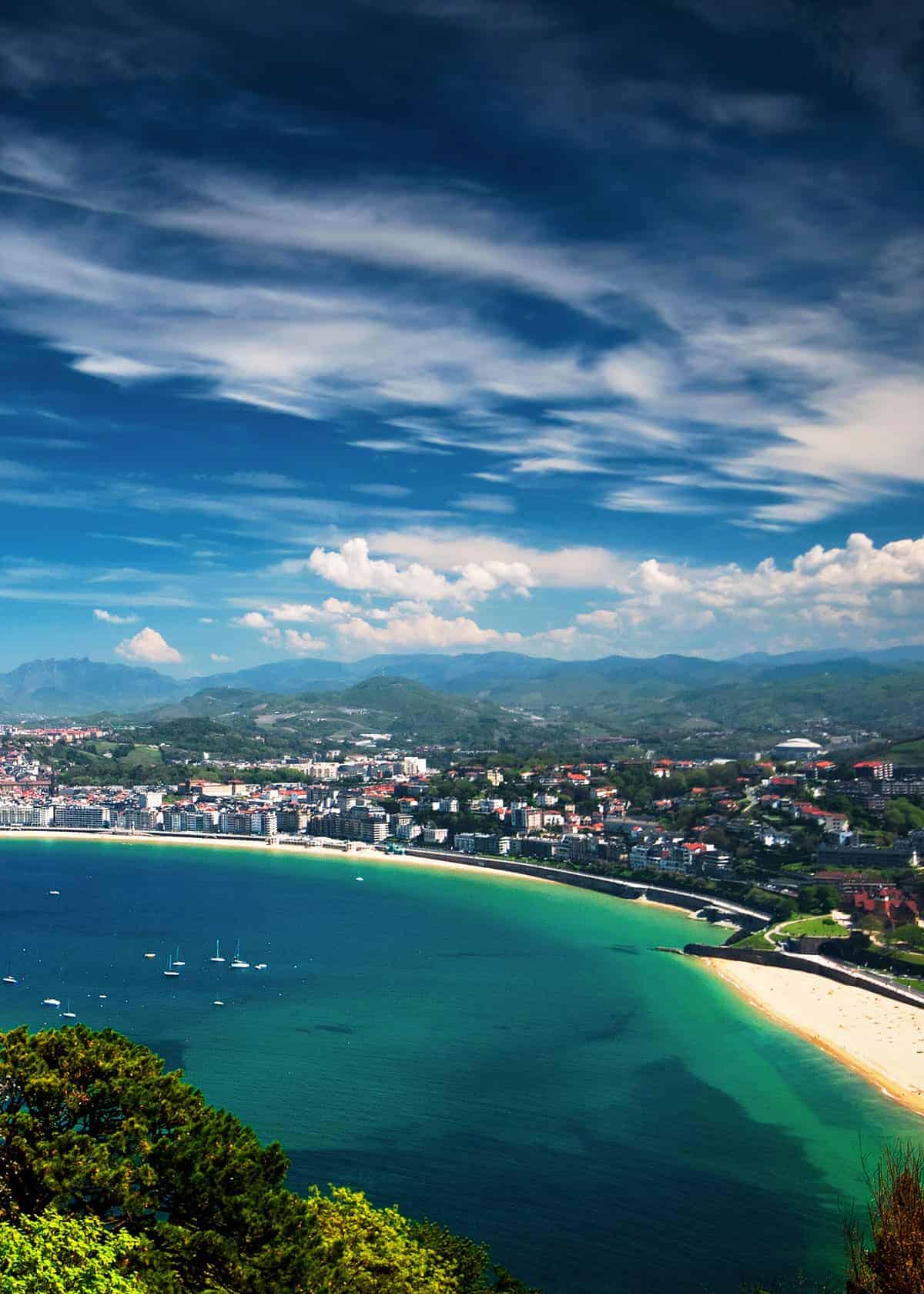
Culture in Spain
64. What are some of the different cultures in Spain?
Spain is home to four key regions on its mainland and several regions located on islands in the ocean.
Most people who live in the country are Roman Catholics, though a large percentage of residents do not adhere to any religious beliefs. Basque, Catalan, Valencian and Andalusian are some of the cultural groups who live in Spain today.
What is up with Catalonia?
65. What is the population of Spain?
The official population of Spain stands at more than 46 million people.
66. Is Spain’s population increasing or decreasing?
Spain’s population increases every year and has so since the 1950s. The nation saw its population grow from less than 30 million residents in 1950 to more than 46 million today.
67. How many immigrants live in Spain?
The number of immigrants living in Spain now includes more than 6.4 million people. They represent 14% of the country’s total population.
The majority of immigrants in Spain come from the EU and neighboring countries. While less than 32,000 Romanians immigrated to Spain in 2001, the number who moved there in 2014 climbed to more than 700,000.
68. Where do the immigrants in Spain come from?
More immigrants come to Spain from Romania than any other country. There are more than 730,000 Romanians living in Spain today.
Other countries will a high number of immigrants in Spain include Morocco, the United Kingdom, Ecuador, Italy, Columbia, China, and Germany.
Spain Immigration and Expat Facts
69. What is the best place to live in Spain?
Barcelona ranks as the top choice for expats moving to Spain because so many of the people who live in the city were not born there.
Though Madrid and Seville are other popular choices, you can also live in a smaller town such as Palomares or Granada. Some expats live on the Canary Islands or near the coast.
70. What are the requirements to live in Spain?
How can I immigrate to Spain? If you want to live in Spain and are not a resident of an EU country, you must have a visa in hand before you visit. That visa provides you with entry to the country.
Short-term visas are best for short trips, while long-term visas are best for those who want to establish residency. You will need to begin the process of staying there within 30 days of your original arrival. Spain requires that you live there for at least 10 years before you can become a citizen.
71. How do you become a citizen of Spain?
Is it hard to become a citizen of Spain? Not everyone wants a full decade to become a citizen of Spain.
If one or both of your parents are Spanish citizens, you can apply for citizen status, even if your parents no longer live in the country.
You can also become a citizen if you marry someone who is a resident of Spain, even if the marriage takes place in another country. Spain requires that you have a job and references who can speak on your behalf when you apply to become a citizen.
72. Is it easy to get permanent residency in Spain?
It is not easy to become a citizen of Spain, though you will have an easier job establishing a permanent residency.
You can apply for a temporary residency permit, which lets you reside there for up to five years. Before the permit expires, you can request a new one to extend your stay. To become a full resident or citizen of Spain, you need to have a full-time job or some way to support yourself and an established residence.
The country will also look at whether you have a bank account and if you filed and paid your taxes.
73. How long can I live in Spain?
The amount of time that you can live in Spain depends on the type of permit or visa you obtain.
Short-term visas give you three months to visit the country and decide what you want to do next.
Long-term visa let you stay beyond three months. You can apply for a permit that lets you live there for five years, though you won’t have the same rights that citizens do. Spain ties some visa dates to the purposes of visits. If you come for a college semester, your visa will expire within days of the last date of the semester.
74. How long can I stay in Spain without a visa?
You should not even think about staying in Spain without a valid visa.
If the local police stop and ask for your ID and you present an expired visa, officers can take you back to the station. They can then contact the government and begin the deportation proceedings.
If your visa is in danger of expiring, talk to the consulate or the embassy. Government officials can help you apply for a new visa, which will give you more time to stay.
You need to show some type of proof as to why you should remain in the country though. A good example is that you have a student visa but you want to enroll in a new university course. Spain will often let workers extend their stays if they can prove that their employers still need them.
75. How can I work in Spain?
To work in Spain, you must have a Foreigner’s Identity Number. Also called an NIE, it serves the same purposes as an American social security number does.
This number allows you to apply for a driver’s license and open a bank account, but it also gives you the right to work in Spain. Your employer will use this number to take taxes from your checks.
It can take four weeks to get an NIE in the United States, but you can complete the process much faster when you arrive in Spain.
Unless you are Swiss or come from another country in the EU, you must also have a work permit. Spain only grants work permits to those who are 18 or older. It makes an exception for those who are self-employed and allows those workers to get a permit as long as they are 16 years old.
76. What percentage of Spain are immigrants?
Approximately 14% of all the people living in Spain are immigrants. This figure includes people from other parts of the EU such as the UK and Germany and the number of people coming from other nations, including China and the United States.
77. How many expats are in Spain?
As you look for facts about Spain, you may want to consider the difference between an expat and an immigrant. Expats are individuals who move to a foreign country and plan to live there for a temporary period of time before they return to their native countries.
Immigrants are those who permanently move to a new country. While the number of immigrants living in Spain is high, its number of expats is lower. Around 310,000 expats from England and other countries in the UK account for the number of expats in Spain.
The number of expats from the US and other nations is 100,000 or less.
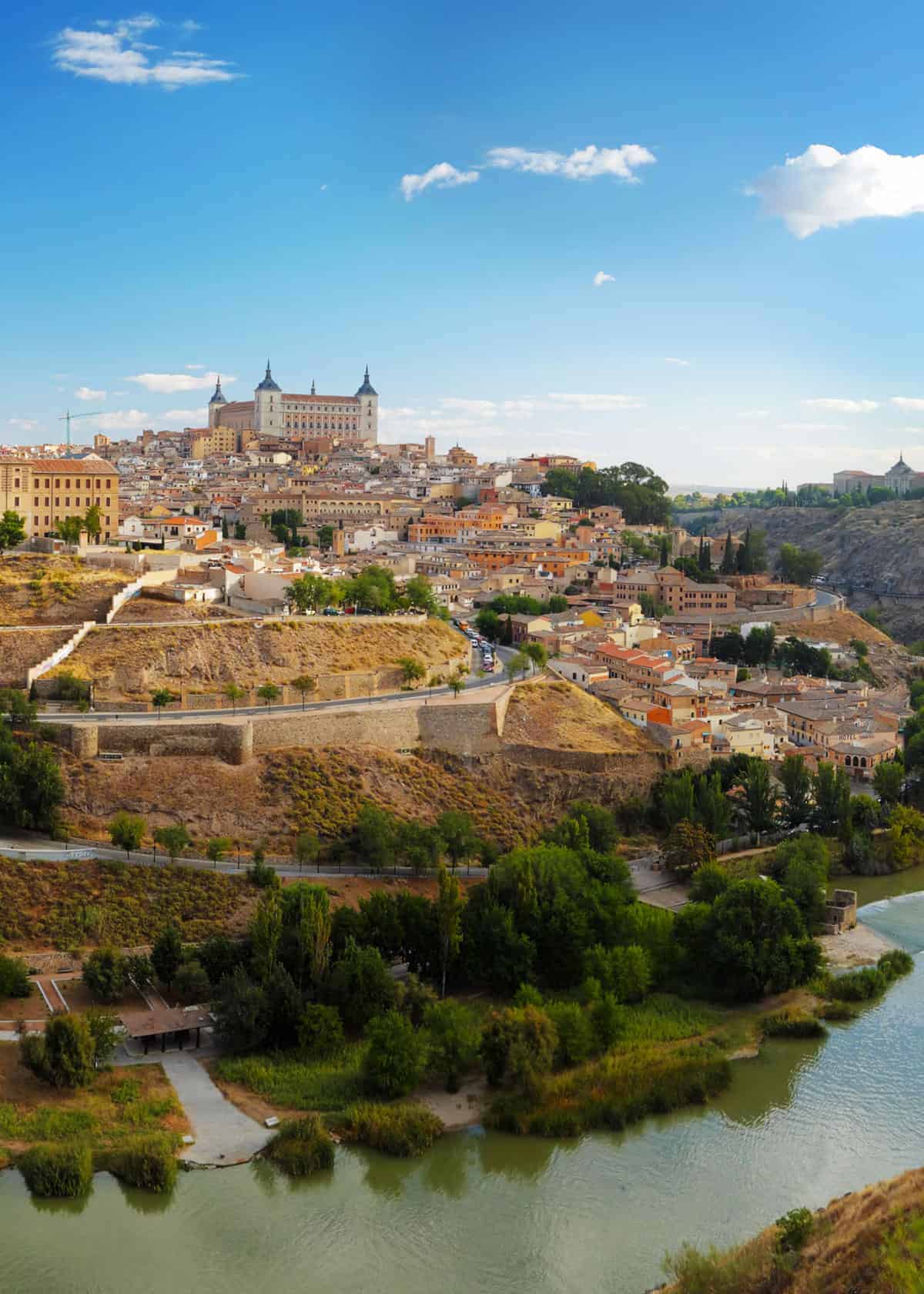
Your Turn
Have a fact about Spain to share? Or maybe a question about visiting/living in Spain? Join me in the comments!


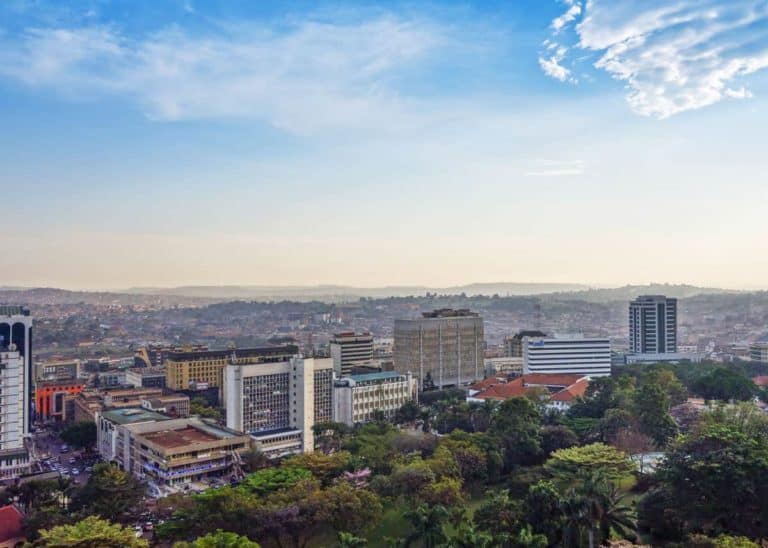



![15 Incredible Things to do in Uganda [Culture, Nature, Culinary, Adventure…]](https://storyteller.travel/wp-content/uploads/2018/10/things-to-do-in-uganda-768x548.jpg)